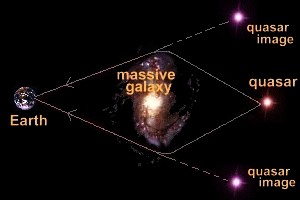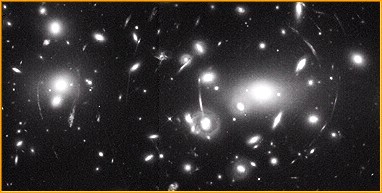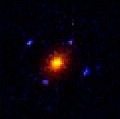|
An ordinary glass lens causes light to bend because the light slows down when it passes through the glass. Converging light rays from an object, as seen through glass, will be distorted in size and shape, and the image may be magnified. You can see this effect with a spoon in a glass of water; it's called refraction.  Albert Einstein described how light could also be affected by gravity. A strong force of gravity from a very massive object will cause the path of a ray of light to bend towards the object. Albert Einstein described how light could also be affected by gravity. A strong force of gravity from a very massive object will cause the path of a ray of light to bend towards the object. The massive object could be a star like our sun, or a black hole, or a huge galaxy of billions of stars. The larger the object (the more massive), the stronger its force of gravity, and the more the light will be bent from its original path. Einstein's prediction was verified by scientists who observed a star behind the sun during an eclipse ... its light was being bent around the sun, making it visible. Today, huge telescopes like the orbiting Hubble telescope can see billions of light years out into the universe, and there are some amazing things to see! Quasars are huge sources of energy at the edge of the visible universe that may possibly be galaxies containing giant black holes. They are very bright, and their light has to travel a long distance before it reaches us.  If the light from a distant quasar should pass near a massive galaxy, the force of gravity from that galaxy may be enough to cause the light to change direction. If the light from a distant quasar should pass near a massive galaxy, the force of gravity from that galaxy may be enough to cause the light to change direction.Now consider that the galaxy is very tiny in comparison to the distance to the quasar (unlike the not-to-scale picture at the left). This means that light from the quasar may be passing the galaxy on both sides. Both beams of light will get bent, and may end up travelling in a new direction. If Earth is in their path, we will see two images of the quasar! And neither image is where the quasar actually is. In a photograph, we will see the galaxy, and two images of the quasar that is behind it, one on either side.
If the massive galaxy is off-centre with respect to the path of light from the quasar, the two images will appear at different distances, as they do in the photo just above. An astrophysicist can use the known mass of the galaxy, its distance, and the apparent distance to the two images, along with some simple geometry, to calculate the distance to the actual quasar. In gravitational lensing, an intervening galaxy acts as a lens to focus the image of the distant quasar to a new location. Images of other galaxies, as well as quasars, can also be formed this way. Since galaxies occur in clusters, the light from an entire cluster of galaxies can be bent in all directions around a massive intervening galaxy, causing them to appear in a circular formation around the massive object. Here's a photograph that illustrates this phenomenon nicely: 
Light takes many billions of years to reach us from this quasar. Since light takes a different amount of time to travel each path, each image shows the quasar as it appeared at a slightly different time in the past! The images themselves give us information about the conditions in the universe 10 to 15 billion years ago. Also, the time delays between images are influenced by how fast the universe was (and is) expanding, so analysis of this image helps reveal Hubble's constant, a number that measures the universe's rate of expansion. |

